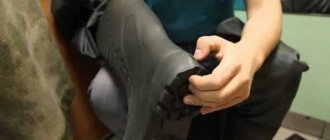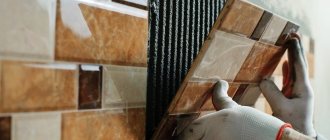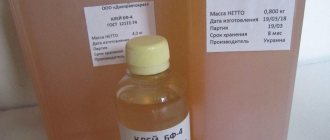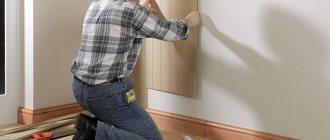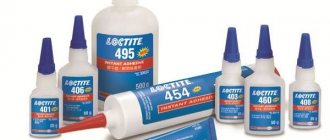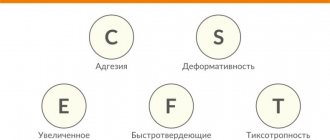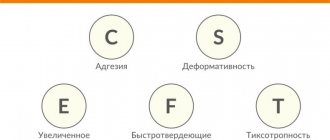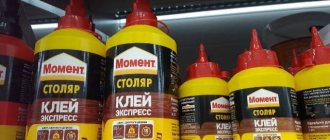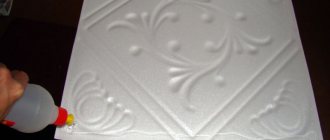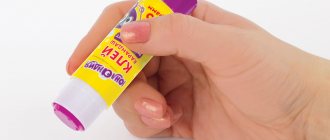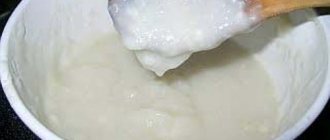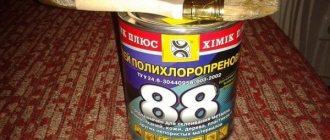BF-2 glue (phenol polyvinyl acetate) was developed by G.S. Petrov back in the middle of the 20th century, but there are still no analogues to it in composition. The adhesive mixture has a viscous, not too thick consistency, a pungent odor and not a very bright color. The technical characteristics of the composition guarantee strong bonding of any surfaces.
It is considered the best when restoring antique items. Suitable for modeling. Used in medicine (dentistry), in the furniture industry. The adhesive should not be used for kitchen or other products in which food is prepared, stored or consumed. It is actively used in the repair of acoustic equipment and radio devices.
Specifications
| Characteristic | Description |
| Appearance | Transparent liquid. Slight turbidity with a yellow or partially red tint is acceptable. |
| Conditional viscosity | 30-60 s at temperature +20°C |
| Dry residue fraction | 14-17% |
| Shear strength of adhesive joint | 19.5-20 mPa or 200 kgf/sq.cm. at a temperature of +20°C |
| Bend of the dried glue seam | < 3 mm |
The use of BF-2 provides strong adhesive seams with low elasticity. The glue easily withstands high temperatures (up to 200 °C). Working properties of the adhesive composition:
- invulnerability to mold;
- resistance to chemicals, acetone, gasoline and alcohol;
- viscosity in the range of 30-60 Pa*s at a temperature of 20-25°C.
The viscosity of the glue can be increased by storing it at sub-zero temperatures.
Before use, the product must be kept at room temperature for at least 1-2 days. Heating the product with a hairdryer or storing it near heating appliances is dangerous.
How to remove BF glue
The medical version of the glue dissolves on its own within 2-3 days. Or the elastic film can be easily removed if you pick it up on one side and gently pull it up.
To remove technical compounds, you can use a mechanical method (if the surface allows). If there is a risk of damaging the surface, use alcohol or acetone-containing liquids.
To do this, moisten the cloth with alcohol or acetone and apply liberally to the area of the adhesive stain. Leave for 20–30 minutes. Then apply solvent again and carefully clean off with a rubber spatula or flat plastic piece.
Areas of use
The use of BF-2 glue is recommended for joining parts that will not move during operation or be subject to dynamic loads. The result must remain motionless, otherwise the seam itself may become deformed. This is due to its inelasticity after hardening.
Glue can be used to connect:
- metal;
- tile;
- tree;
- marble and porcelain stoneware;
- glass;
- ceramics;
- polymer coatings.
The parts glued together can be of different materials, for example, a wooden base with glass or plastic with ceramics.
BF-2 has different release forms: tubes, cans and small bottles
Where and when is BF-2 glue used?
In accordance with the manufacturer's instructions, the main purpose of the adhesive mixture is gluing rigid parts and surfaces that are immovable during operation and do not experience operational dynamic loads.
The adhesive solution can be used to connect surfaces made of the following materials:
- metal;
- plastic;
- wood;
- marble;
- glass;
- ceramics;
- tile.
The composition is used for joining homogeneous and dissimilar materials. When working with this glue, it is necessary to apply the adhesive mixture in two layers (in accordance with the manufacturer's instructions) to ensure maximum quality of surface bonding. The adhesive solution can be applied hot or cold (the choice is made in accordance with the capabilities and requirements of the consumer).
BF-2 adhesives and other compounds from this series have been actively used in our country in the past for the repair of various acoustic devices. It can also be used as a varnish or impregnation composition for materials subjected to restoration or restoration.
Instructions for use
The composition requires double application of layers. BF-2 can be used to cover surfaces as an alternative to paint and varnish products and impregnation, for example, in the process of restoring something.
The instructions consist of a step-by-step process.
- Processing areas that need to be glued later. The work depends on the characteristics of the materials themselves, for example, metal needs to be cleaned with sandpaper and thoroughly wiped with a rag soaked in gasoline (or any other composition with a degreasing effect). Plastic and glass can be treated with a hot baking soda spray.
- It is better to apply the adhesive mixture with a clean thin brush on both sides. The glue layer should be thin and uniform. If it is applied cold, it takes 20 minutes to dry; when applied hot, it takes at least an hour.
- The second layer must be applied using the same method as the first (either cold or hot). There should be no gaps or leaks.
With the hot gluing method, the joined parts must be clamped in a vice and placed in the oven for 60 minutes. The internal temperature should be around 130-140 °C. When gluing cold, after applying the second layer, you need to wait 2-3 minutes, then press the parts tightly and leave everything in a warm, ventilated room for a day. The hot joining method can be used when working with marble, metal and earthenware. Cold – for the restoration of vases, dishes and various models. The part will be ready for use in no less than 24-48 hours.
If glue gets on the skin of your hands, it should be washed off with regular running water.
Varieties
The BF series includes many adhesive compositions that were manufactured in the USSR and continue to be produced in Russia at several enterprises. The series includes the following products, in addition to BF-2:
- BF-4. It is used for joining highly elastic materials that will bend and be subject to vibration loads during operation. Scope of application: metal, wood, leather products, surfaces made of textolite, plexiglass, etc. Used for the production of getinax.
- BF-6. Used for joining flexible products and parts (leather, textile). Actively used in the medical field (dentistry).
- BF-19. Can be used for hot joining of glass, ceramic, wood, textile, and metal products. For cold gluing: paper, rubber, cardboard, polymer, fabric, leather items. It is highly toxic and therefore cannot be used in medicine.
- BF-88. Used for joining non-metallic and metallic products. Used in the medical field to seal large wounds. Non-toxic. Resistant to moisture and temperature changes. Combusts when exposed directly to an open flame.
- BF-2n, BF-4n. Limited scope of application - only products and parts made of ferrous metals.
All types of BF glue that can be used for medical purposes are usually sold in pharmacies or specialized medical stores. It is almost impossible to find them in hardware and construction stores. It is recommended to buy BF glue only at large specialized sales points. If the mixture is to be used for medical purposes, it is necessary to ensure that the composition is genuine and safe to use.
Review of BF glue (2 videos)
Glue BF-6 (15 photos)
Storage and transportation
Phenol polyvinyl acetate glue brand BF-2 should be stored in hermetically sealed containers.
Do not allow it to be near a source of fire or possible fire. The storage place should be out of reach of children, dark and dry. The mixture itself can only remain in its original packaging.
Transportation is possible by rail, road, and air. The main condition is compliance with sub-zero air temperatures.
Storage conditions:
Store the glue in a hermetically sealed container at a temperature of 0 to 25ºС.
An increase in viscosity is allowed during transportation and storage at sub-zero temperatures. Before using this glue, it must be kept at a temperature of 25ºC for at least 3 days.
Warranty period of storage
glue from the date of manufacture for at least
10
months. After the warranty period has expired, the adhesive can be used for its intended purpose after checking its quality.
Do you know that…
The popular name for BF glue is “Boris Fedorovich”. Often used as a substitute for alcohol. To do this, water was added to the glue, a jar of glue was placed on a drilling machine (or milling machine), a drill (or a piece of welding electrode) was inserted into it, and the machine was turned on. As a result, during the rotation of the twist drill, adhesive substances collected on it, and a more or less pure solvent (ethyl alcohol) remained in the jar. This procedure was called "drilling out." The safety of the prepared drink depended entirely on the skill of the machine operator and, of course, on the composition of the glue itself. At home, to prepare an alcohol-containing liquid, they usually used a hand-held electric drill, with rags, ropes, etc. wrapped around the drill. The procedure for obtaining an alcohol-containing liquid at home was called “kicking out the heifer” (option: “kicking out the goat”). “Telkom” (or “goat”) was the name given to the mass of adhesive fraction concentrated on the drill.
Currently, the method is unsuitable, because BF has not been made with ethyl alcohol for a long time, and the chemistry on the basis of which the bulk of adhesives, conventionally called “BF”, are now made has been little studied by science and is certainly not good for health.
Glue BF-2.pdf
Analogs
There is not a single analogue of the BF-2 category. None of the manufacturers use phenol-formaldehyde resin as a component. You can choose a replacement that matches the technical characteristics of the BF-2 as closely as possible.
For example, “Super cement” has a reduced adhesion ability of the composition and the strength of the finished seam. Not intended for use on metal surfaces. You can try replacing the glue with any product made on the basis of epoxy resin. It is toxic and fire hazardous. This must be remembered before starting use.
The manufacturer has a variety of adhesive mixtures of the BF brand.
- BF-2n or BF-4n (only for ferrous metal).
- BF-4 can be used to maintain the elasticity of seams that will be susceptible to vibration.
- Medical glue BF-6 is the best option when working with textiles and leather, and is used in medicine.
- BF-19 is non-toxic, connects ceramics, wood and textiles (hot method), rubber, cardboard, leather and textiles (cold method).
- BF-88 is a fire hazardous product that firmly connects metal and non-metallic components.
All types of glue used in medicine (dentistry) are purchased in pharmacies or specialty stores that sell medical equipment.
Glue composition
Depending on the specific brand, the chemical composition of BF glue may be different. All products in the series are produced in accordance with GOST 12172-74.
By deciphering the name (butyraphenol glue), a specialist will understand that the main component is polyvinyl butyral (or polyvinyl acetal). The number after the BF brand indicates the percentage of the main component in the dry matter, which gives the material elasticity.
Different types of BF may have an unequal number of such components - the more there are, the higher the plasticity of the dry adhesive layer, but the lower the strength. The glue contains:
- phenol-formaldehyde or phenol-polyvinyl acetate resin;
- ethyl alcohol (solvent).
The last component can be replaced by the manufacturer with chloroform or acetone. Medical glue BF-6 is dissolved only with alcohol.
In appearance, all products are thick solutions of yellowish, brown, brown, reddish color. Adhesives are flammable.
Parameters of compositions and areas of their application
Brands of BF glue differ in composition, and, accordingly, in properties and characteristics.
The most popular brands are BF-2 and BF-4. They have similar thermal and chemical resistance, but still have differences in the rules of use.
Most BF adhesives are universal and can be used in everyday life, however, it is worth considering that some components in their composition are toxic.
Glue BF-2
The annotation for this product indicates its scope of application: gluing objects and products whose operation does not involve their movement. Using this composition you can impregnate and varnish some materials.
BF-2 does an excellent job of gluing glass, marble, plastic, ceramic, and wooden parts.
These properties have allowed BF-2 glue to prove itself well in working with bas-reliefs, antique objects, and, in the past, with sound devices such as microphones, speakers and other acoustic equipment.
BF-2 can withstand high temperatures - up to +180 degrees, and in an acidic environment it remains stable at temperatures from +60 to +80 degrees Celsius.
Main characteristics of the material
- contains from 14 to 17% dry residue in the composition
- the amount of bend formed after curing of the adhesive film does not exceed 3 mm
- as a result of high-temperature polymerization, it creates a seam with low elasticity
- the viscosity of BF-2 at +20 degrees Celsius is 30-60 s (according to the readings of the VZ-1 viscometer)
- the static strength of the adhesive joint in shear has a limit of at least 19.6 MPa
Storing the product at temperatures below 0 degrees Celsius may lead to an increase in the viscosity of the composition. Therefore, it is recommended to place the container with glue in a room at room temperature for 72 hours before starting work.
The BF-2 product is resistant to various substances, such as water, oil, kerosene, mold, gasoline. Partially susceptible to acetone, alkali and alcohol.
Glue BF-4
The composition is intended for use on products that bend and are subject to vibration. Can fasten copper, parts made of aluminum-magnesium alloys, steel, fiberglass, leather, wood, glass and other surfaces.
Using BF-4 you can glue non-metallic parts to metal ones.
Main characteristics of the material
- the highest strength of the seams is achieved after high-temperature polymerization (the required exposure temperature is from 160 to 175 degrees Celsius). Do not exceed the recommended heating temperature, as after reaching the temperature limit the strength begins to decrease
- the amount of bend formed after curing of the adhesive film does not exceed 1 mm
- contains 10-13% dry residue in the composition
- the viscosity of BF-4 at temperatures above 20 degrees Celsius ranges from 30 to 60 s (according to the readings of the VZ-1 viscometer)
- the static strength of the adhesive joint in shear has a limit of at least 19.6 MPa
- impact on the surface bonded with BF-4 glue reduces the strength of the adhesive joint
Adhesives BF-2N and BF-4N
Designed for working with parts and products made of ferrous metals. The viscosity indicators, tensile strength and the proportion of dry residue in these products coincide with the parameters of BF-2 and range from 30 to 60 s, 19.6 MPa and 14-17%, respectively.
Products fastened using these grades should be operated at temperatures not lower than -60 and not higher than +80 degrees Celsius.
Glue BF-88
A universal composition capable of combining a wide variety of materials: metals with non-metals, wood, fabric, leather, ceramics, plastic and other natural and synthetic materials.
Used for repairs and other household work. The basis of the product is formed by components such as nefras, ethyl acetate, chloroprene rubber and phenol-formaldehyde resin. Visually it is a viscous beige or gray-green substance.
Precipitation may occur. Release form: industrial containers with a volume of 25 to 50 liters.
Glue BF-19
The product is highly toxic, which makes it unsuitable for use with cookware and other similar utensils.
Also, BF-19 cannot be used in medicine. However, diluted with acetone according to the instructions, the product can be used for both hot and cold gluing.
The first method is suitable for wooden, metal, ceramic, and glass surfaces. The second method is to glue plastic, cardboard, rubber, paper. To glue the fabrics, you will have to use an iron.
Glue BF-6
A product based on bakelite varnish is often used in medicine. With its help, a protective film is created on the surfaces of abrasions and wounds.
The antiseptic effect of the product is used in the treatment of postoperative sutures and in dental work.
Contraindications for use are allergies to the components of the drug and children under 1 year of age.
Procedure for using BF-2 and BF-4
Before using these products, the surface should be prepared.
It is carried out in several stages: first, the surface is treated with sandpaper, then thoroughly cleaned of the smallest particles of dust and other contaminants and degreased.
To work with both compositions, both hot and cold gluing methods are used. Hot gluing using BF-4 glue consists of the following steps
- An even layer of adhesive is applied to the parts
- time maintained - 60 minutes
- the parts are pressed tightly against each other and held for 40 minutes at a temperature of +150 to +170 degrees Celsius
- the product is left until it cools to room temperature
When gluing fabrics, proceed as follows: pre-wet the fabric in water, wring it out and dry it for 60 minutes.
After this, apply a thin layer of adhesive, connect the parts and iron with a hot iron. The glue dries completely in 5 hours.
When using the cold gluing method, the product is applied in two layers with an interval of 20 minutes between applying the first and second, after 2 minutes the parts are pressed against each other. It takes a day to dry
BF-2 glue is applied in two layers with an interval of 10 minutes.
Next, the parts are compressed and placed for one hour in an oven with a temperature of +130 to +140 degrees Celsius - if a hot gluing method is used, or clamped for 20 minutes in a vice and transferred to a well-ventilated room for 24 hours - if cold gluing is used.
